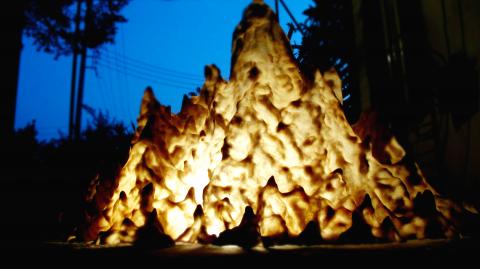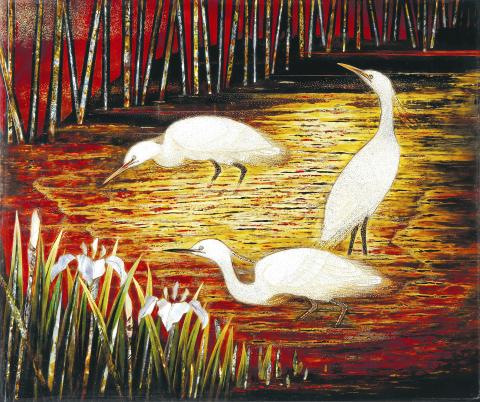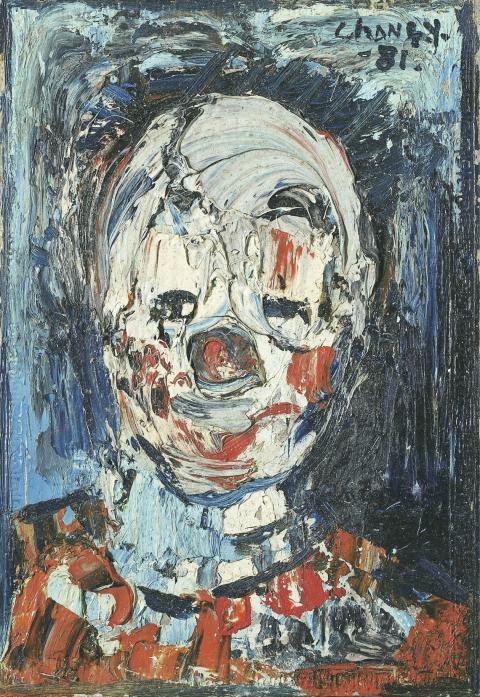Black Mist—Achiever of Light (黑色幻霧—光的成就者) is a solo exhibition of black sculptures inspired by the female figure. Contemporary sculptor Huang Ying-Pu (黃映蒲) has fashioned 22 pieces — including a pelvis, an ovary and a supine woman giving birth — that appear shrouded in shadow yet luminous, in an effort to reduce the female form to a primal maternal essence.
■ Taipei’s Songshan Cultural and Creative Park (松山文創園區), 33, Guangfu S Rd, Taipei City (台北市光復南路133號), tel: (02) 2765-1388, open daily from 10am to 9pm, free admission
■ Until Tuesday

Photo courtesy of VT Artsalon
The Art of Crafts (承薪.成藝) brings together works by five artists at the top of their field: tin sculptor Chen Wan-neng (陳萬能), woodcarver Shi Zhen-yang (施鎮洋), lacquer artist Wang Qing-shuang (王清霜), bamboo weaver Huang Tu-shan (黃塗山) and Shi Zhi-hui (施至輝), who specializes in gilded Buddha figurines. The exhibition also offers documentary screenings and workshops taught by the artists and their apprentices. To register, visit the Arts of Crafts Web site (Chinese only) at www.cichilife.com/aoc.
■ Bopiliao Old Street (剝皮寮歷史街區), 101 Guangzhou St, Taipei City (台北市廣州街101號), tel: (02) 2336-2798, open Tuesdays to Sundays from 10am to 6pm
■ Opens tomorrow. Until Dec. 15

Photo courtesy of Bureau of Cultural Heritage
The Sunday of Life (生命的禮拜天) celebrates the 100th birthday of Chang Yi-hsiung (張義雄), a Chiayi native who rose from poverty to become an acclaimed western-style painter. As a child Chang wanted to become an artist, but received little formal training due to financial hardship. Later in Japan, he cut paper silhouettes of passersby on the street to support himself. Learning mainly through trial and error, Chang riffs off western art movements such as Impressionism, Fauvism, Cubism and Expressionism, applying them to everyday people and scenes of Taiwan. On view are representative works from Chang’s career, including his famed portraits of clowns.
■ National Taiwan Museum of Fine Arts (國立臺灣美術館), 2, Wuquan W Rd Sec 1, Greater Taichung (台中市西區五權西路一段2號) tel: (04) 2372-3552. Open Tuesdays to Fridays from 9am to 5pm, Saturdays and Sundays from 9am to 6pm
■ Until Feb. 9

Photo courtesy of National Taiwan Museum of Fine Arts
Lin Chien-jung (林建榮) is an installation artist best known for his “light bulb man,” a playful sculpture that turns its glass head like it’s pondering the deeper stuff of life. Lonely Island, A Self-Portrait (孤島,一種自我摹寫的狀態) is a more grotesque turn on introspection. Lin’s latest exhibition features a large gray rock that’s programmed to light up and dim rhythmically. The rock is a metaphor for the self; deeper inspection reveals nothing except slimed barnacles and black space.
■ VT Artsalon (非常廟藝文空間), B1, 17, Ln 56, Xinsheng N Rd Sec 3, Taipei City (台北市新生北路三段56巷17號B1), tel: (02) 2597-2525. Open Tuesdays through Saturdays from 1:30pm to 9pm
■ Opening reception tomorrow at 7pm, until Dec. 14
Paper artist Reiko Nireki visited Greater Taichung and Chiayi to observe the locals’ relationship with ancient forests. The Wishing Tree (許願樹) is her solo exhibition on Taiwanese tree culture. Using paper and sculpture, Nireki builds a forest at MOCA Studio that’s filled with totems of local rites, such as the red charms used on the birthday of the tree god. A second room is an ode to Japanese tree culture: An ornate tree is crafted out of wrinkled layered paper and marked with a branch, which in Shinto rites constitutes a wordless apology to a tree that’s destroyed for human use.
■ MOCA Studio, Museum of Contemporary Art, Taipei (MOCA, Taipei), 39 Changan W Rd, Taipei City (台北市長安西路39號), tel: (02) 2552-3720. Open Tuesdays to Sundays from 10am to 6pm. Admission: Free
■ Until Dec. 22

In the March 9 edition of the Taipei Times a piece by Ninon Godefroy ran with the headine “The quiet, gentle rhythm of Taiwan.” It started with the line “Taiwan is a small, humble place. There is no Eiffel Tower, no pyramids — no singular attraction that draws the world’s attention.” I laughed out loud at that. This was out of no disrespect for the author or the piece, which made some interesting analogies and good points about how both Din Tai Fung’s and Taiwan Semiconductor Manufacturing Co’s (TSMC, 台積電) meticulous attention to detail and quality are not quite up to

Chinese Nationalist Party (KMT) Chairman Eric Chu (朱立倫) hatched a bold plan to charge forward and seize the initiative when he held a protest in front of the Taipei City Prosecutors’ Office. Though risky, because illegal, its success would help tackle at least six problems facing both himself and the KMT. What he did not see coming was Taipei Mayor Chiang Wan-an (將萬安) tripping him up out of the gate. In spite of Chu being the most consequential and successful KMT chairman since the early 2010s — arguably saving the party from financial ruin and restoring its electoral viability —

It is one of the more remarkable facts of Taiwan history that it was never occupied or claimed by any of the numerous kingdoms of southern China — Han or otherwise — that lay just across the water from it. None of their brilliant ministers ever discovered that Taiwan was a “core interest” of the state whose annexation was “inevitable.” As Paul Kua notes in an excellent monograph laying out how the Portuguese gave Taiwan the name “Formosa,” the first Europeans to express an interest in occupying Taiwan were the Spanish. Tonio Andrade in his seminal work, How Taiwan Became Chinese,

Toward the outside edge of Taichung City, in Wufeng District (霧峰去), sits a sprawling collection of single-story buildings with tiled roofs belonging to the Wufeng Lin (霧峰林家) family, who rose to prominence through success in military, commercial, and artistic endeavors in the 19th century. Most of these buildings have brick walls and tiled roofs in the traditional reddish-brown color, but in the middle is one incongruous property with bright white walls and a black tiled roof: Yipu Garden (頤圃). Purists may scoff at the Japanese-style exterior and its radical departure from the Fujianese architectural style of the surrounding buildings. However, the property